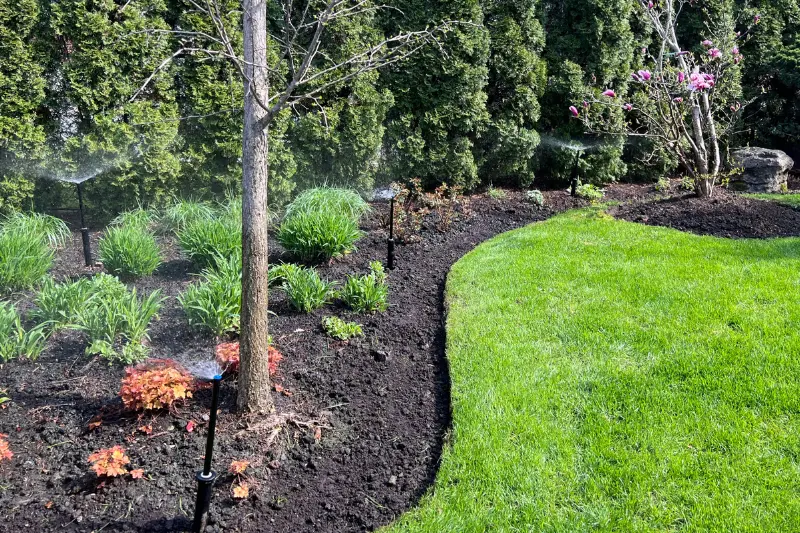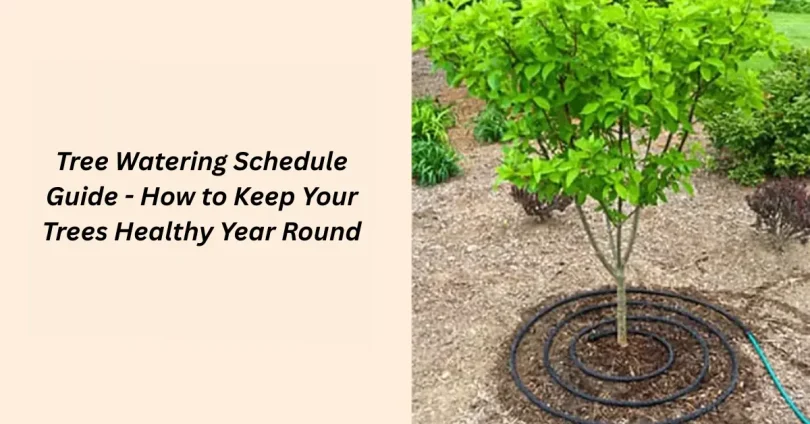Introduction:
Watering trees may seem simple, but doing it the right way makes a big difference in how healthy your trees stay throughout the year. Whether you’re caring for a young sapling or a large mature tree, following a proper watering plan is key. This Tree Watering Schedule Guide – How to Keep Your Trees Healthy Year Round will help you understand when, how often, and how much to water your trees in each season. It’s easy to follow and perfect for beginners and experienced gardeners alike!
What is a Tree Watering Schedule Guide?

A Tree Watering Schedule Guide is a simple plan that helps you know when, how often, and how much to water your trees throughout the year. It takes into account important factors like the age of the tree, the type of soil, the weather, and the season.
By following a watering schedule, you can make sure your trees get just the right amount of water—not too much and not too little. This helps your trees grow stronger, stay green, and avoid common problems like dry roots or overwatering.
You May Also Like It:
How to Protect Trees During Storms – Essential Tips for Tree Safety
How to Spot Overwatering vs Underwatering: Key Plant Care Signs
Plant Nutrition & Fertilizer Guide | Essential Tips for Healthy Growth
Why is a Tree Watering Schedule Guide Important?
Creating and following a proper tree watering schedule helps your trees stay strong, healthy, and beautiful all year long. Here’s why it truly matters:
Promotes Strong Root Growth
- Deep watering encourages deep roots: Trees with deep roots are more stable and can access more nutrients and moisture.
- Helps trees withstand drought: A solid root system helps trees survive dry spells without stress or damage.
- Prevents surface root growth: Shallow watering can lead to weak, surface-level roots that make trees unstable.
Prevents Overwatering and Underwatering
- Avoids root rot and fungal issues: Too much water suffocates roots and creates the perfect conditions for diseases.
- Prevents leaf yellowing and drop: Inconsistent watering causes stress, leading to leaf damage and early shedding.
- Ensures consistent moisture: A schedule keeps soil moisture balanced, preventing extreme wet or dry cycles.
Saves Water and Time
- Reduces water waste: A planned schedule means you only water when needed, saving valuable water resources.
- Makes care more efficient: Knowing when and how much to water takes the guesswork out of tree maintenance.
- Supports eco-friendly gardening: Efficient watering supports sustainable and responsible tree care practices.
Encourages Seasonal Tree Health
- Adjusts to seasonal needs: Trees need different amounts of water in summer, winter, spring, and fall.
- Supports proper dormancy and growth cycles: Correct watering helps trees rest in winter and grow in warmer months.
- Prepares trees for weather changes: A good schedule strengthens trees before heatwaves or frosts arrive.
Improves Overall Tree Longevity
- Keeps trees healthy longer: Proper hydration helps prevent diseases and stress-related decline over the years.
- Boosts resistance to pests and weather: Healthy trees are stronger and better equipped to handle storms or insects.
- Increases property value and beauty: A thriving tree adds long-term value and visual appeal to your home or landscape.
Helps Young Trees Establish Quickly
- Supports early root development: Young trees rely on frequent, deep watering to grow strong and healthy roots.
- Reduces transplant shock: A steady watering schedule helps new trees adapt to their new environment faster.
- Builds a strong foundation for growth: Proper care early on ensures the tree grows straight and stable for years to come.
Prevents Common Tree Health Problems
- Stops wilting and leaf browning: Regular watering keeps leaves hydrated and reduces signs of stress.
- Reduces pest attraction: Stressed or dry trees are more likely to attract insects and other harmful pests.
- Protects against fungal diseases: Consistent moisture control prevents overwatering that can lead to mold or fungus.
Step-by-Step Guide: Tree Watering Schedule Guide

Step 1: Identify the Age of Your Tree
- Young trees (0–3 years) need more frequent watering because they are still establishing roots.
- Mature trees (3+ years) need deeper, less frequent watering to maintain strength and health.
Step 2: Understand Your Soil Type
- Sandy soil drains quickly, so trees may need to be watered more often.
- Clay soil holds water longer, so watering can be less frequent.
- Loamy soil is balanced and ideal for a steady watering schedule.
Step 3: Check the Weather Conditions
- Increase watering during hot, dry spells or droughts.
- Reduce watering during cool, rainy periods to avoid overwatering.
- Skip watering if the soil is already moist from recent rainfall.
Step 4: Use the Right Watering Method
- Use a soaker hose or drip irrigation to ensure deep and even watering.
- Water at the drip line (edge of the tree canopy), not directly at the trunk.
- Avoid overhead sprinklers as they can waste water and may not reach the roots.
Step 5: Follow a Seasonal Watering Schedule
| Season | Watering Frequency |
|---|---|
| Spring | Every 7–10 days |
| Summer | Every 2–3 days (young trees), 7–10 days (mature trees) |
| Fall | Every 10–14 days |
| Winter | Once a month if the soil is dry and unfrozen |
Step 6: Monitor Soil Moisture
- Use a moisture meter or simply stick your finger into the soil.
- If the top 2–3 inches are dry, it’s time to water.
- Keep the soil moist, not soggy.
Step 7: Apply Mulch Around the Base
- Add a 2–4 inch layer of mulch around the tree base, but not touching the trunk.
- Mulch helps retain moisture, keeps roots cool, and reduces weed competition.
Step 8: Adjust as the Tree Grows
- Reduce watering frequency as trees mature and develop stronger root systems.
- Re-evaluate your watering routine each season or after major weather changes.
- Keep records to track what works best for your specific trees.
Advantages and Disadvantages of a Tree Watering Schedule Guide
| Advantages | Disadvantages |
| Promotes Healthy Tree Growth A consistent watering schedule helps trees develop strong roots, healthy leaves, and stable trunks. | Requires Regular Monitoring You need to keep track of weather, soil moisture, and tree health, which can be time-consuming. |
| Prevents Overwatering and Underwatering By following a plan, you reduce the chances of drowning the roots or drying them out. | May Vary by Tree Type and Soil Different trees and soils have different needs, so the schedule may need adjustments for best results. |
| Saves Water and Time Targeted watering avoids waste and makes caring for trees more efficient and eco-friendly. | Can Be Difficult for Large Landscapes Managing a watering schedule for many trees across a big yard or property can be challenging without automation. |
| Boosts Tree Longevity Trees that receive the right amount of water are less likely to suffer from stress, diseases, or die early. | Initial Learning Curve Beginners may find it hard at first to understand soil types, tree needs, and how much water is just right. |
| Adapts to Seasonal Needs The guide adjusts your watering habits to fit each season, helping your trees thrive all year round. | May Not Account for Unexpected Weather Sudden storms or heatwaves can throw off your schedule, requiring quick adjustments to avoid damage. |
You May Also Like It:
Common Tree Diseases and Effective Treatment Methods – Tree Care Guide
Best Time to Trim Trees – Seasonal Guide for Healthy Growth
How to Keep Indoor Plants Healthy | Essential Tips for Thriving Houseplants
Common FAQs – Tree Watering Schedule Guide
Q1: How often should I water my trees?
It depends on the age of the tree. Young trees need water every 2–3 days, while mature trees need deep watering every 7–14 days.
Q2: What time of day is best for watering trees?
Early morning or late afternoon is best. This helps reduce water loss from the sun and gives roots time to absorb moisture.
Q3: How can I tell if my tree needs water?
Check the soil 2–3 inches below the surface. If it’s dry, your tree likely needs water.
Q4: Can I water my trees too much?
Yes. Overwatering can lead to root rot and other problems. Always check soil moisture before watering again.
Q5: Do trees need water in winter?
Yes, if the soil isn’t frozen and there hasn’t been rain or snow, water your trees once a month.
Q6: Where should I water—at the base or around the tree?
Water around the drip line (the outer edge of the tree’s canopy), not directly at the trunk. This is where the roots absorb water best.
Q7: What’s the best way to water trees?
Use a soaker hose or drip irrigation system. These give slow, deep water that reaches the roots.
Conclusion
Keeping your trees healthy all year starts with a simple watering schedule. By knowing when, how often, and how much to water, you can help your trees grow stronger, live longer, and stay green through every season. A little care goes a long way—just follow the steps and your trees will thank you!
Bonus Points – Tree Watering Schedule Guide
- Use a Rain Gauge: Track how much rain your trees are getting so you don’t overwater when nature does the job for you.
- Install a Drip System Timer: Automate your watering schedule with a timer to make sure your trees get water even when you’re busy or away.
- Group Trees by Water Needs: If you have multiple trees, group those with similar watering needs to save time and water.
- Refresh Mulch Seasonally: Replace mulch every few months to help hold in moisture and keep roots cool and protected.
- Keep an Eye on Tree Leaves: Wilting, yellowing, or browning leaves can be early signs of overwatering or underwatering—watch them closely.
You May Also Like It:
Tree Pruning Tips for Beginners – Easy Guide to Healthier Trees
Why Your Plant Leaves Are Turning Yellow | Common Causes & Easy Fixes
Natural Remedies for Plant Pests | Eco-Friendly Pest Control Tips 2025
How to Care for Trees in Your Backyard – Tree Maintenance Tips 2025






